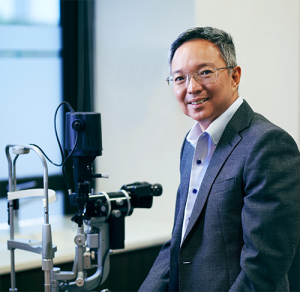Cataract surgery is a procedure performed by ophthalmological doctors and specialists that takes less than 15 – 20 minutes and significantly improves the quality of life of previously blind patients. However, there are occasionally some issues that can arise following cataract surgery. These occur in about 2 to 3% of eyes.
One such issue is when the posterior lens capsule/membrane sometimes becoming hazy after cataract surgery. It happens following cataract removal. The eye tries to create a new lens and is unsuccessful, leading to haziness of the lens membrane. This is when YAG laser capsulotomy becomes necessary.
YAG laser capsulotomy, often referred to as laser posterior capsulotomy, is a procedure used to clear up cloudy posterior capsules that might occasionally develop after patients have had cataract surgery. YAG laser capsulotomy creates an opening in the natural lens capsule of the eye and clears the clouded back lining of the lens, allowing light to enter the eye more easily and improving vision.
Signs You Need a YAG Laser Capsulotomy
When the posterior capsule experiences noticeable fibrosis, wrinkling, or opacification, it becomes necessary to undergo a YAG laser capsulotomy procedure. These elements, if left untreated, may result in blurred vision, glare, or issues with visual function. Other complications that indicate the need for YAG laser capsulotomy include:
Posterior Capsule Opacity
Posterior Capsule Opacity, PCO for short, is a known occurrence among post-cataract treatment and cataract surgery patients, occurring in about 2-3% of eyes. PCO occurs when scar tissue forms behind your lens implant after cataract surgery. This can result in blurry or hazy vision and intense glare from lights.
Capsular Block Syndrome
The Intraocular Lens Implant (IOL) may partially occlude the anterior capsulorhexis opening, resulting in capsular block syndrome, which can result in a buildup of material behind the lens after cataract treatment. This can result in impaired vision due to the haziness caused by the buildup.
Capsular Bag Distension Syndrome (CBDS) is a rare complication that materialises after cataract treatment. It is characterised by the presence of turbid fluid, which can sometimes be misinterpreted as vitritis (vitreous floaters), between the IOL and posterior capsule.
How is the YAG Laser Capsulotomy Procedure Done?
YAG laser Capsulotomy is a quick and safe surgical procedure with a few simple steps:
- Anaesthetic and dilating eye drops will be applied to the eye before beginning the procedure. The patient should feel no pain at all.
- The cataract doctor or attending specialist will then create an opening in the lens capsule lining using the YAG laser. This is necessary to allow light rays to focus toward the back of the eye.
- After a few minutes, the procedure is done. You may have to wait inside the eye care clinic for an hour to allow the specialist to monitor you.
Improvement in your vision should occur within 24 hours after the procedure and you’ll be able to perform normal tasks without vision problems soon after.
Regain your Eye Health and Vision with Eyewise Vision
YAG laser capsulotomy may seem daunting and overwhelming at first glance. But with the help of a cataract doctor and specialist, you can easily plan out the procedure to restore your vision.
Eyewise Vision is an eye care clinic in Singapore that can perform the procedures you need to regain your eye health and normal vision, giving you confidence to live your life to the fullest. Our services include cataract surgery and treatment, diabetic eye screening, and dry eye treatment in Singapore led by our trusted Ophthalmologists.
Book an appointment with us for a consultation today, or to know more about how we can help improve and fix your vision. You can also look at our blog for eyecare tips and resources, such as how to protect your eyes from UV light and what you need to know about diabetic eye screening.

Dr. Christopher Khng, specializes in Complex Cataract and Anterior Segment Reconstruction Surgery, in particular, Iris Reconstruction and surgery for Aniridia. His other areas of expertise include Complex Lens surgery, New Lens and Phacoemulsification technologies, Refractive surgery, Phakic IOLs (the Implantable Collamer Lens, ICL), and small-incision, topical anesthesia phacoemulsification cataract surgery. Dr. Khng is a member of the Singapore Medical Association (SMA), a Fellow of the American Academy of Ophthalmology, the American Society of Cataract and Refractive Surgery (ASCRS), and the European Society of Cataract and Refractive Surgery (ECSRS). He is registered with the Singapore Medical Council (SMC) in Singapore and with the General Medical Council (GMC) for practice in the United Kingdom.

